
 Magyarul / Hungarian
Magyarul / Hungarian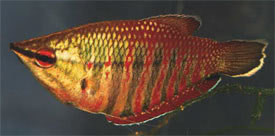
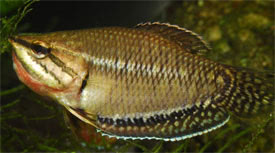
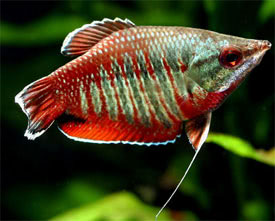
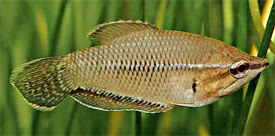
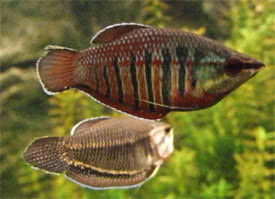
- Scientific name: Sphaerichthys vaillanti
- Synonyms: -
- Common name: Samurai Gourami, Vaillant's Chocolate Gourami
- Group: Labyrinth fishes
- Habitat: Asia, endemic to the Kapuas river drainage.
- Size: 4,5-5,5 cm
- Biotope: Slow-moving forest rivers and streams, which are characteristically black waters because of the rotting leaves and humic acids from decaying organic material.
- Social behavior: Because of its small size, if combined with other fish, keep with other small, calm, non aggressive species. However it does seem to require interaction with conspecifics, so it is best kept in a small group of 6 fish.
- Diet: Carnivorous, give them only live, and frozen foods, such as daphnia, grindal worm; Only small live food is accepted by wild caught fish. It may not accept dried foods.
- Breeding: Quite hard
- Tank: Minimum 50 litres
- Population: 6 fish for 80 litres
- Decoration: Needs a heavily planted tank with a bottom of fine sand. Add some larger stones and roots, and provide plenty of hiding places. The addition of dried leaf litter will stain the water, and will make the fish more confortable.
- Temperature: 21-25 °C
- pH: 3.5-6.5
- Hardness: 0-5 NK°
- Lifespan: 3-5 years
Description: Sphaerichthys vaillanti males have a pale lateral stripe extending from behind the the eye to the caudal-fin base, and there is a concurrent dark stripe under the pale one, which is thinner and less intense. Females have a series of alternating red and green vertical bars on their body, and the body near the head is predominantly greenish, while towards the tail is more reddish. On both fish there is a dark line running from the mouth through the eye. Fungal infections are far more common in cases where they are kept in water conditions far from the conditions their native habitat has provided them. Due to human activity, which have increased dramatically since the late 1990s the fish is added to the IUCN Red List of Threatened Species as Vulnerable (VU). Because of the water pollution due to illegal gold mining in the Kapuas region, the deforestation, and overfishing a significant percentage of Sphaerichthys vaillanti populations may have already been lost.
It is a little hard to tell the difference between sexes though females always possess a uniformly straight lower jaw profile and more pointed head shape, while males have slightly rounded lower jaw with distensible skin that is expands during mouthbrooding. However in fully-acclimatised fish the sexes can be easily tell apart, because females have a red and green pattern, while males remain brownish. Samurai Gourami is a paternal mouthbrooder. The fish can be bred in pairs or in a small group, where the courtship is initiated by the dominant female. To get Sphaerichthys vaillanti to breed the water should be extremely soft and acidic. The spawning process can last to several hours with eggs laid and fertilised on the substrate, and the male collecting them in his mouth. The spawning area is defended by both fish. At this point the male takes refuge in a quiet area of the tank and eats only very little. The male keeps the eggs in his mouth for 7-20 days before 10-40 fully-formed, free swimming fry are released. A couple days after spawning the male can be separated to a smaller tank, or the free swimming fry can be seaparated after the male releases them. Usually the fry are large enough to eat baby brine shrimp. Small daily water changes should also be performed in order to maintain water quality, and the tank should have a tight cover as the fry need access to a layer of warm, humid air to ensure proper development of their labyrinth organ.






